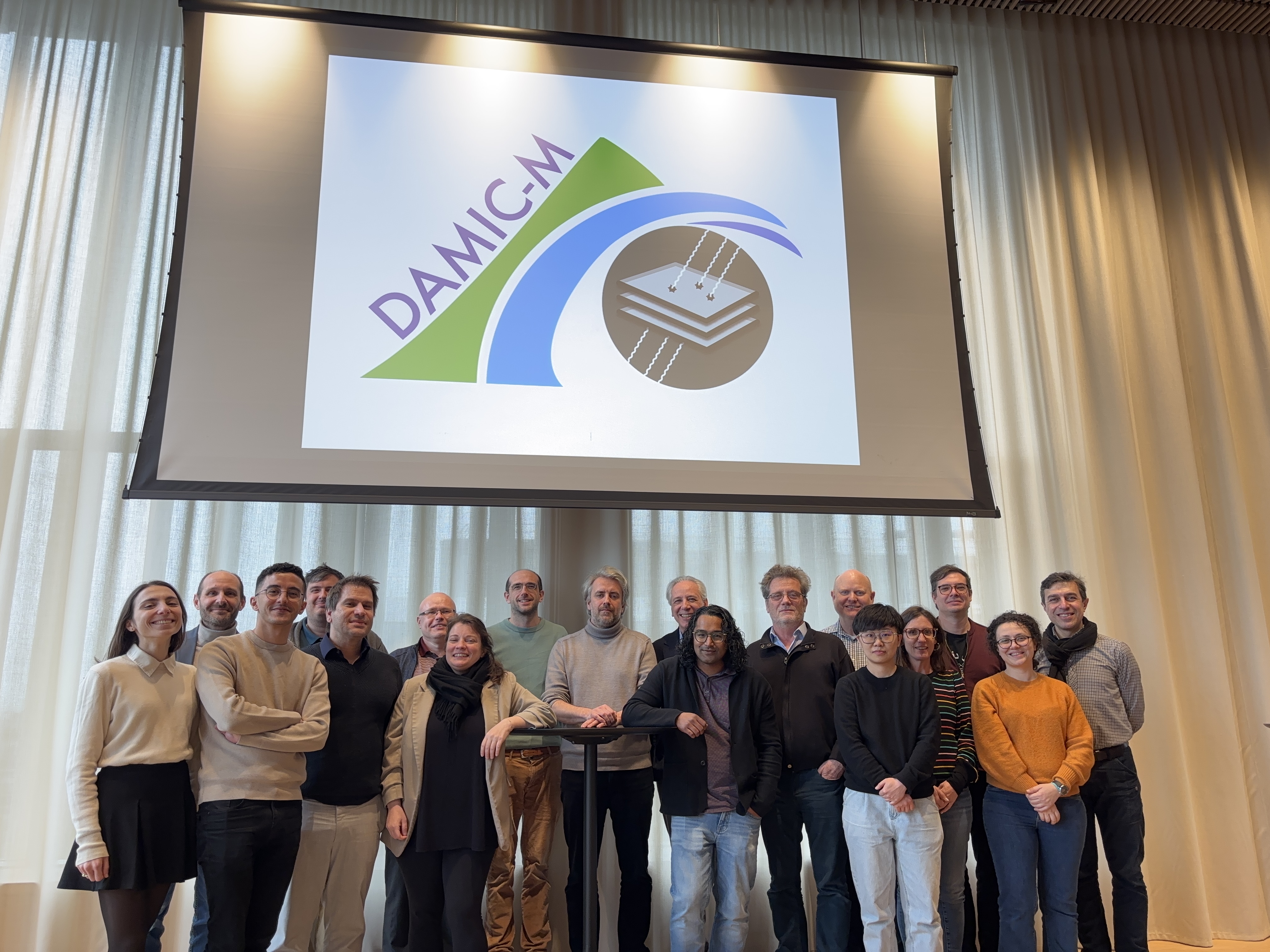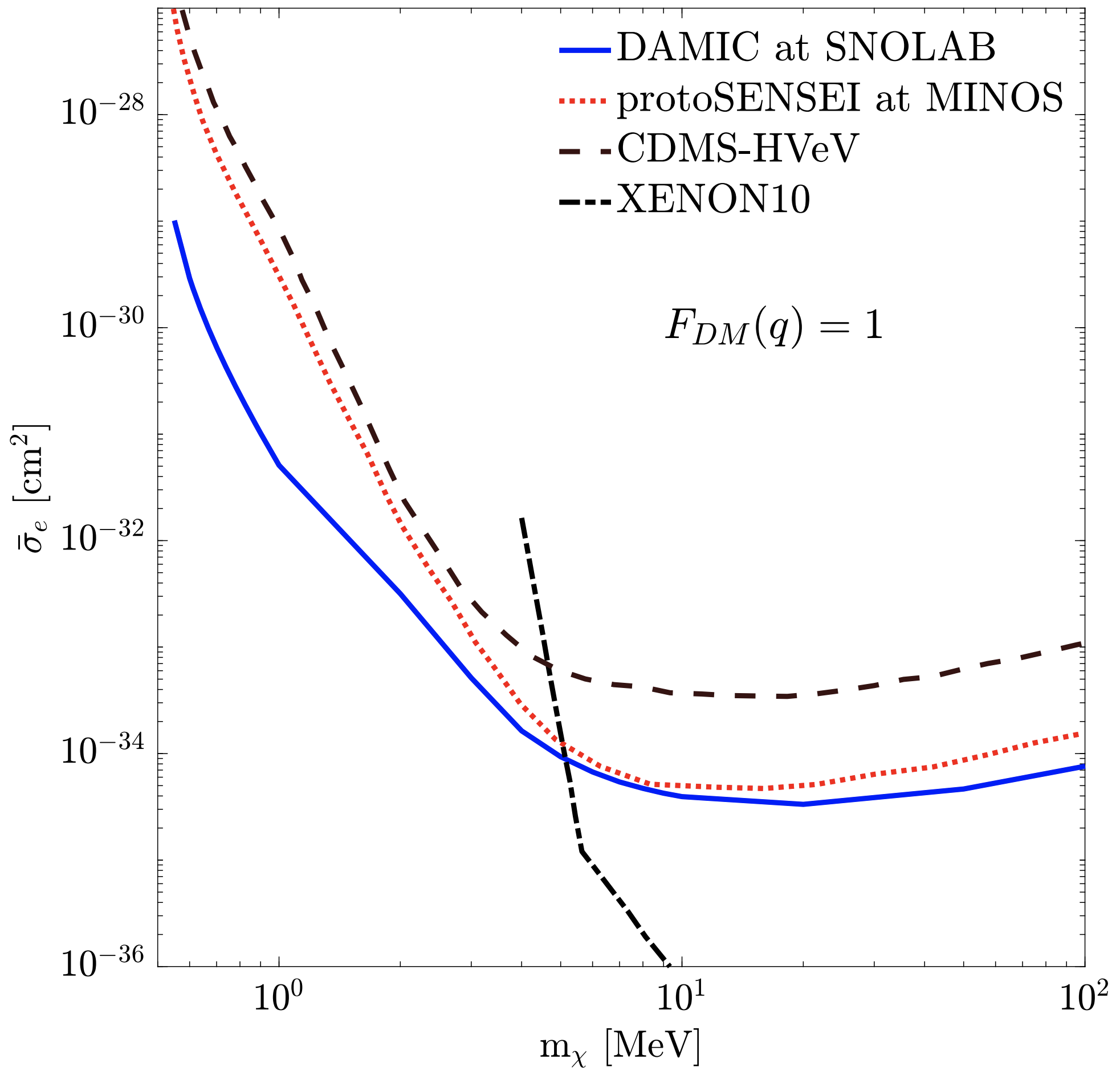| Home | Science | Detector | Collaboration | Publications & Talks | Events | LSM | internal |
Science
|
Probing Benchmark Models of Hidden-Sector Dark Matter March 30, 2025 New results on the search for dark matter particles with the LBC operating at the Modane Underground Laboratory. With an improvement of orders of magnitude in sensitivity with respect to any other detector technology, DAMIC-M new results exclude for the first time that dark matter may be primarily composed of hidden-sector particles with sub-GeV mass ("freeze in" light blue line in figure).Learn more >> Search for Daily Modulation of MeV Dark Matter Signals March 30, 2025 Dark Matter (DM) particles with sufficiently large cross sections may scatter as they travel through Earth's bulk, giving rise to a characteristic daily modulation signal. The figure shows 90% C.L. upper limits on DM interacting with electrons through a ultralight mediator, obtained by searching for a daily modulation signal in DAMIC-M skipper CCDs installed in the Low Background Chamber. This work was published in Physical Review Letters on 7 March, 2024.Learn more >> First Constraints on Sub-GeV Dark-Matter Particles Interacting with Electrons March 30, 2025 Results from the first underground operation of DAMIC-M, with an integrated exposure of 85.23 g days. The figure shows 90% C.L. upper limits on dark matter interacting with electrons through a ultralight mediator, obtained with DAMIC-M prototype skipper CCDs installed in the Low Background Chamber. These results were highlighted as Editors' Suggestion by Physical Review Letters and published on 28 April, 2023.Learn more >> Installation of the Low Background Chamber at the Modane Underground Laboratory March 30, 2025 The Low Background Chamber (LBC) has been installed and commissioned at the LSM in 2022. The LBC cryostat is open in the photo, showing the ancient Roman lead shielding surrounding the copper box with the CCDs. Precision measurement of Compton scattering in silicon with a skipper CCD for dark matter detection March 30, 2025 We report a precision measurement of Compton scattering on silicon atomic shell electrons down to 23eV. A skipper charge-coupled device (CCD) with single-electron resolution, developed for the DAMIC-M experiment, was exposed to a 241Am γ-ray source over several months. Features associated with the silicon K, L1, and L2,3-shells are clearly identified, and scattering on valence electrons is detected for the first time below 100eV. We find that the relativistic impulse approximation for Compton scattering, which is implemented in Monte Carlo simulations commonly used by direct detection experiments, does not reproduce the measured spectrum below 0.5keV. The data are in better agreement with ab initio calculations originally developed for X-ray absorption spectroscopy.Learn more >> DAMIC-M Collaboration Meeting, Feb 10-12 2025 February 12, 2025 The DAMIC-M Collaboration at the John W. Boyer Center of the University of Chicago in Paris on February 10-12.Learn more >> DAMIC-M recognized experiment at CERN January 1, 2020 DAMIC-M has been been given the status of recognized experiment at CERN.Learn more >> Constraints on Light Dark Matter Particles Interacting with Electrons December 18, 2019 We report direct-detection constraints on light dark matter particles interacting with electrons. The results are based on a method that exploits the extremely low levels of leakage current of the DAMIC detector at SNOLAB of 2–6×10^-22 A cm^−2. We evaluate the charge distribution of pixels that collect <10e- for contributions beyond the leakage current that may be attributed to dark matter interactions. Constraints are placed on so-far unexplored parameter space for dark matter masses between 0.6 and 100 MeV c^-2. We also present new constraints on hidden-photon dark matter with masses in the range 1.2–30 eV c^-2.Learn more >> DAMIC-M kick-off meeting in Paris, June 11-13 2018 June 28, 2018 DAMIC-M collaborators gathered at The University of Chicago Center in Paris for a kick-off meeting of the experiment.Learn more >> Paolo Privitera has been awarded an Advanced Grant by the European Research Council for DAMIC-M June 19, 2018 Paolo Privitera has been awarded a 4 M$ Advanced Grant by the European Research Council to search for light dark matter particles with DAMIC-M. The European Research Council ''selects and funds the very best, creative researchers of any nationality to run projects based in Europe'', with Principal Investigators of Advanced Grants identified as ''exceptional leaders in terms of originality and significance of their research contributions.''Learn more >> |











